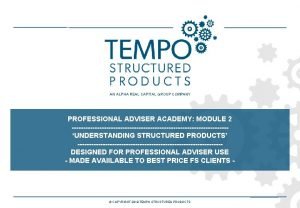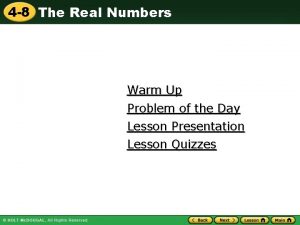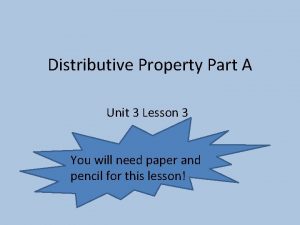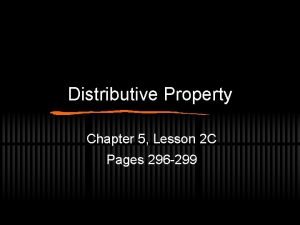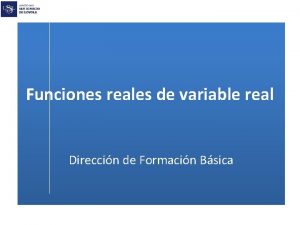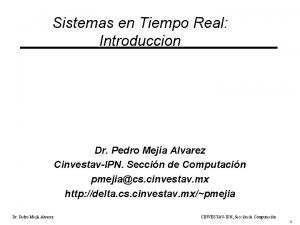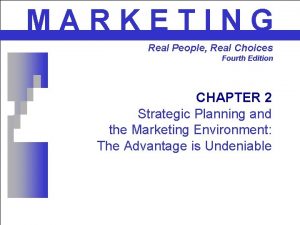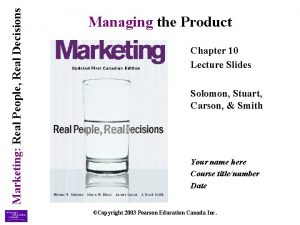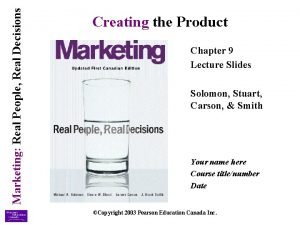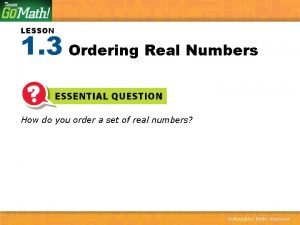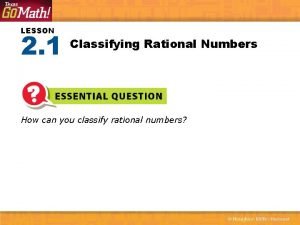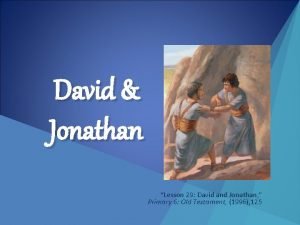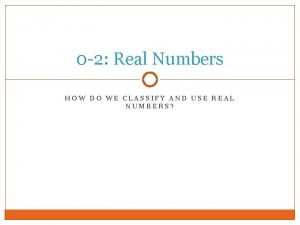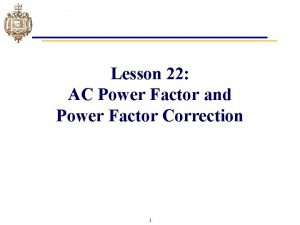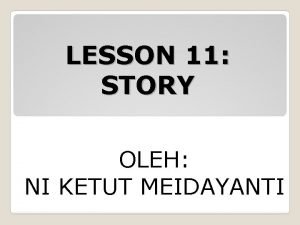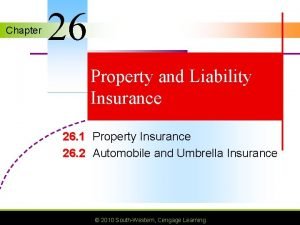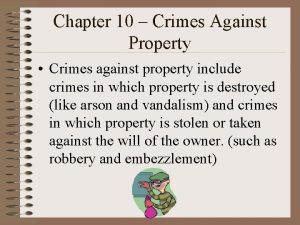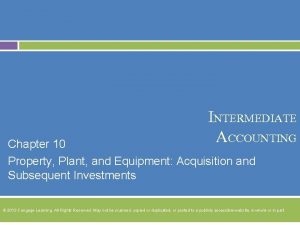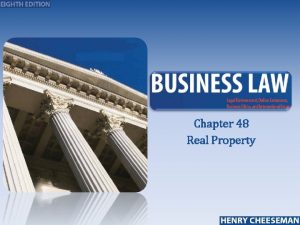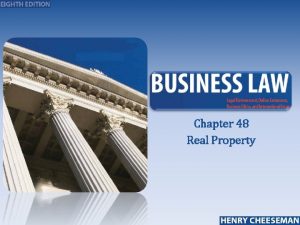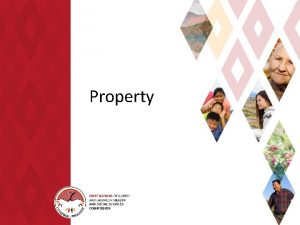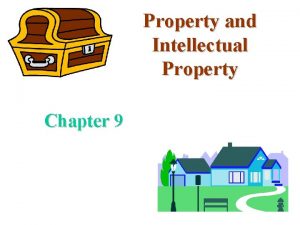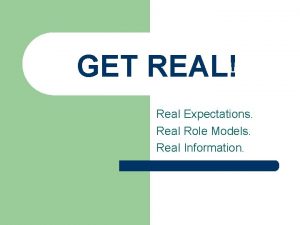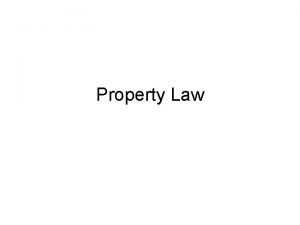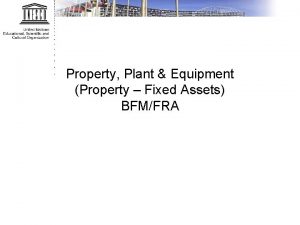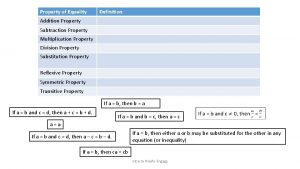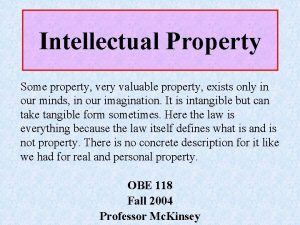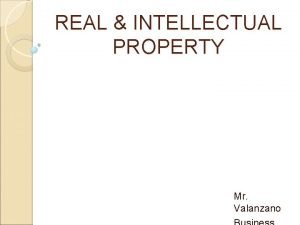Chapter 21 Real Property Lesson 1 What is






































- Slides: 38

Chapter 21 Real Property Lesson 1 – What is Real Property Lesson 2 – Nature and Transfer of Ownership Lesson 3 – Other Rights in Your Land

Lesson 21 -1 Identify the physical and legal elements of real property • Describe the major test used to distinguish real/personal property • Classify items as real or personal •

Real Property Rights Real Property includes land, things permanently attached to land, and certain rights to use the land of others. Surface Rights Right to Air Space Mineral Rights Water Rights

Real Property Rights Surface Rights – the buyer usually purchases the surface rights to use the land of others. Land – The basic physical element of realty. Right to Air Space – The air space above the surface of the land is also part of the realty and is the ownership of the person who buys the land. Ownership power, except for the right to exclude aircraft from flying over, extends to the upper atmosphere.

Real Property Rights Mineral Rights – Realty also includes the earth beneath the surface. Right to dig or mine the earth is mineral rights. Extends down from the land surface to the center of the earth. Solid Minerals – Ownership of solid minerals such as coal, iron ore, copper ore, nickel, and uranium extends downward to the surface parcel. Owner has the power to remove any mineral in the area. Fluids – Ownership of fluids such as oil (liquid), natural gas (vapor) also extends downward fro the surface. Capture of fluids belongs to the one who extracts it.

Real vs Personal Property The ability to distinguish between real and personal property is critical to understanding many transactions. Different bodies of law govern transfers of real and personal property. Uniform Commercial Code (UCC) – governs personal property Common Law of Contracts – governs sale of realty

Real vs Personal Property Tax treatment of real and personal property varies greatly. Usual test for distinguishing real and personal property is that real property is land immovable things attached to the land. Personal property is a movable thing. Example: Stove is personal property and a house is real property.

Real vs Personal Property Three general test of mobility Attachment Structures Fixtures Crops Adaptation Intention

Attachment Structures – Structures or buildings are part of the real property if they are permanently attached to the land. Classrooms in a high school are part of realty. A house trailer sitting on wheels as a temporary classroom is personal property. If the house trailer wheels were removed, it would be realty.

Attachment Fixtures – When personal property is permanently attached to realty it is called a fixture and treated as real property. Built-in Stoves and dishwashers that are permanently attached are part of realty Free standing stoves is personal property.

Attachment Crops – When a crop is harvested, example: corn, it is treated as personal property even while it is in the ground. Crops are not considered permanently attached to the land. Grapevines and rose bushes would be real property.

Adaption This test will cause certain items to be classified as realty because they are truly essential to the functioning of realty. Examples – The toilet and the key to the front door Both are personal property, but are essential to the functioning of the home.

Intention Sometimes parties reach agreements about how property is to be classified. Example – Tenant wants to install a certain dishwasher and take it with them when they leave. Trade Fixtures – Items of personal property attached to realty by business tenants. Unlike other fixtures, trade fixtures are treated as personal property because they are usually not intended to be permanent.

Lesson 21 -2 Describe the major estates in land • Identify the legal names of parties involved in deeding realty • Describe the processes for transferring ownership of land •

Major Estates in Land Ownership of realty is usually acquired by purchase, gift, or inheritance. The powers of ownership are defined by the estate in land that the new owner receives. Each estate is comprised of a certain bundle of ownership rights. The words used in the deed, will, or lease determine which estate is transferred.

Major Estates in Land Grantor – Party who gives up ownership powers Grantee – Party who receives ownership powers Conveyance – A transaction where an estate is transferred from a grantor to a grantee by deed.

Major Estates in Land Fee Simple Absolute – the estate with all the ownership rights. The owner of this estate exercises all the power allowed by law. Almost all buyers of homes, farms, and commercial property purchase the fee simple absolute estate.

Major Estates in Land Conditional Estates – Make the ownership conditional on some act or event. Example – Ownership may exist only “so long as no alcoholic beverages are served on the premises”. Life Estates – Ownership only for the length of a life. The owner of a life estate has the right of possession and exercises all the ownership powers except the right to permanently dispose of the property.

Major Estates in Land Nonfreehold Estates – sometimes called tenancies, involve ownership fro a limited period of time. Tenants who are renting real property own nonfreehold estates. Length of ownership is specified in the lease.

Transfer of Ownership Deed – the legal document used to transfer ownership of real property. Two major types of deeds Quitclaim Deed – transfers any interest the grantor may have in the real property, but don’t guarantee that the grantor owns anything or that the grantee receives anything. Warranty Deed – protects the grantee by providing several enforceable grantor’s warranties.

Transfer of Ownership Principal warranties include: Grantor has the legal ability to transfer realty in the deed. No undisclosed claims or encumbrances against the property (liens, mortgages, overdue taxes) Grantee shall have enjoyment of property and possessions are not disturbed

Transfer of Ownership Inheritance – Ownership of real property may be transferred through a will. If owners die without a will, then all their property including their realty, will be distributed as required by state statutes.

Transfer of Ownership Adverse Possession – Occurs when you adversely and exclusively possess in an open and notorious way the land of another private person. Possession must be continuous for the statutory period of 5 to 21 years, depending on the state law.

Transfer of Ownership Dedication or Eminent Domain Dedication typically involves giving real property to the government, such as a city, for use as a park or roadway. Eminent Domain – the power of the government to take private property for public use in exchange for the fair market price.

Transfer of Ownership Eminent Domain If the owner is unwilling to sell at a price that the government thinks is fair, the government initiates a condemnation proceeding. Condemnation Proceeding – a hearing to determine fair compensation for the owner and acquire ownership for the government.

Lesson 21 -3 Describe and distinguish licenses and easements • Describe when a restrictive covenant binds buyers • Distinguish between valid and invalid zoning • Describe the duties owners owe to persons injured on realty •

Licenses and Easements Two important rights that others have in your land are licenses and easements. License – A temporary, revocable right to some limited use of another’s land. It is personal, nontransferable, not inheritable, and not an estate in land. Example – A seat at the movie theater

Licenses and Easements Easement – Irrevocable rights to some limited use of another’s land. Generally given for substantial periods of time – 5 yrs, 50 yrs, or forever. Easements should be in writing. Example – allowing a neighbor to drive across your land, burying a sewer line, or hanging power lines.

Easements 4 types of Easements 1. Easement Appurtenant – When easements are given to neighboring landowners and the easement benefits the neighbor’s land. 2. Easement in Gross – Easements that do not benefit neighboring land, but benefit a person or business, such as easements for access given to a non-neighbor or for telephone lines or poles.

Easements 4 types of Easements 3. Easement by Necessity – An owner may sell part of her property, and the buyer can only gain access by crossing the seller’s property. 4. Easement by Prescription – If someone makes systematic use of your property for a long period of time, typically 15 to 21 years, then the law will acknowledge use.

Restrictive Covenants and Zoning Ordinances Types of Covenants and Ordinances Restrictive Covenants Zoning Ordinances Invalid Zoning Spot Zoning

Restrictive Covenants and Zoning Ordinances Restrictive Covenants – Promise usually made in writing by the buyer to the seller. Run with the land (follow the land) when the meet Intention to run with the land Affect the use of the property or title of property Buyer must have had notice of covenant at purchase Chain of ownership from original to current owner.

Restrictive Covenants and Zoning Ordinances – adopted by cities or counties to regulate the location of residential, business, and industrial districts. Only enacted when they promote the health, safety, morals, and general welfare of the community.

Restrictive Covenants and Zoning Ordinances Invalid Zoning – Zoning is not enforceable if it exceeds the constitutional powers of the state. Ordinance is clearly arbitrary, unreasonable, or without substantial relation to the health, safety, morals, and general welfare.

Restrictive Covenants and Zoning Ordinances Spot Zoning – the treatment of a single property in a manner inconsistent with the treatment of similar properties in the area. It is usually prohibited. Variance – may be granted by a city/ county allowing landowner to make some use of his/her land that is inconsistent with the general zoning ordinance.

Liens Filed Against Real Property Lien – a legal right in another’s property given as security for the performance of a financial obligation. A mortgage and a trust deed is an involuntary lien which arise without the consent of the owner. Tax lien – when owner don’t pay taxes

Duties Owed to those Entering Your Land A possessor may owe certain tort duties to others who come on the land. Trespass occurs when a person is on the land without the right to be there. Attractive nuisance – something that attracts children to trespass

Duties Owed to those Entering Your Land Licensee – a person whom the possessor of land has permitted to be on that land. Invitee – either a public invitee or a business vistor.
 Commutative and associative properties
Commutative and associative properties Obstructed heritage and unobstructed heritage
Obstructed heritage and unobstructed heritage Chemical property definition
Chemical property definition Commutative property of real numbers
Commutative property of real numbers Real property definition
Real property definition Density property of real numbers examples
Density property of real numbers examples Distributive property of real numbers
Distributive property of real numbers Alpha real property investment advisers llp
Alpha real property investment advisers llp Density property of real numbers
Density property of real numbers Associative property of real numbers
Associative property of real numbers Chapter 1 lesson 1 your total health answer key
Chapter 1 lesson 1 your total health answer key Unit 3 lesson 3 multiplying binomials
Unit 3 lesson 3 multiplying binomials Lesson 2 the distributive property
Lesson 2 the distributive property Lesson 8-5 using the distributive property
Lesson 8-5 using the distributive property Funciones reales
Funciones reales The real real fashion copywriter
The real real fashion copywriter Sensor and (tiempo real or real time)
Sensor and (tiempo real or real time) Real life applications of polynomials
Real life applications of polynomials Marketing: real people, real choices
Marketing: real people, real choices The real thing short story
The real thing short story Marketing real people real choices
Marketing real people real choices Southpointe village apartments fishers in
Southpointe village apartments fishers in Marketing real people real choices 11th edition
Marketing real people real choices 11th edition Marketing real people real decisions
Marketing real people real decisions Marketing real people real decisions
Marketing real people real decisions Lesson 1-3 ordering real numbers
Lesson 1-3 ordering real numbers Classifying numbers venn diagram
Classifying numbers venn diagram Love between jonathan and david primary 6
Love between jonathan and david primary 6 P10 lesson 0-2 real numbers
P10 lesson 0-2 real numbers Power factor lagging means
Power factor lagging means Power triangle diagram
Power triangle diagram Past tense the rabbit and the turtle
Past tense the rabbit and the turtle Chapter 26 property and liability insurance
Chapter 26 property and liability insurance Crime against property
Crime against property Galsworthy quiz
Galsworthy quiz Chapter 10 property plant and equipment
Chapter 10 property plant and equipment Lesson outline lesson 3 describing circuits answers
Lesson outline lesson 3 describing circuits answers Mountain building
Mountain building Lesson outline lesson 2 aquatic ecosystems answer key
Lesson outline lesson 2 aquatic ecosystems answer key







